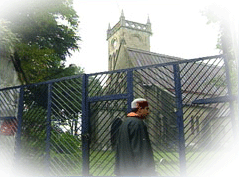History Of Kasauli
Let's get to know how Kasauli got its name. It is believed that way back in the 17th century, when the political scene was pretty twisted, some Rajput families from "Rewari", (that's what they call Haryana today) fled their homes. They flocked to the lower Himalayas, and finally settled in a village called Kasul because of a spring, which kept gushing water all year long. Today, a water reservoir sits on this spring and Kasul has grown into the modern day Kasauli.
But that's not the only story; some locals believe that, Kasauli comes from Kausalya, a mountain stream flowing between Kasauli and Jabli. Wait, there's more. With the valley flowering almost all year, the name could even come from Kusmawali or Kusmali, meaning flower maiden.
The calm and peaceful air of Kasauli belies any sense of history. Yet this region was in the thick of the westward Gurkha  expansion, stemmed with some difficulty by the joint efforts of the British and some local chieftains, in 1814. The Gurkha ceded the fort at Sabathu and this was turned into a convalescent home for British nationals. Some time later the Governor-General, Lord Amherst, decided to develop Shimla Hills as a summer gateway for the British establishment and Col. Tapp, political agent at Sabathu, came to survey the Kasauli area. expansion, stemmed with some difficulty by the joint efforts of the British and some local chieftains, in 1814. The Gurkha ceded the fort at Sabathu and this was turned into a convalescent home for British nationals. Some time later the Governor-General, Lord Amherst, decided to develop Shimla Hills as a summer gateway for the British establishment and Col. Tapp, political agent at Sabathu, came to survey the Kasauli area.
The 1857 Indian War of Independence stirred the hearts of the Kasauli Guard, numbering about eighty Indian soldiers. Receiving news that the Gurkha Regiment at nearby Jutogh has also risen in revolt, the garrison at Kasauli set out to join them. Before the two could combine and pose a serious threat, the British agent talked the Gurkha Regiment into submission, on promise of a general pardon. The Kasauli Guard found themselves completely isolated. So far from being pardoned, they were severely punished for their insurgence.
Kasauli was developed as a cantonment-sanatorium over 20 years, after the British had based themselves at Shimla.Most of the old houses in Kasauli, bought by princely families of Punjab and by generals in the Indian Army around the time of Independence, have been maintained quite well.
On a sultry August morning in 1841 a group of mourners walked home, weighed down by deep sorrow. They had just buried an infant, Letitia Lawrence, in a quiet place below Kasauli. Her grief-stricken parents, Henry and Honoria Lawrence, then decided to build a cottage in Kasauli from where they could see their daughter?s grave(Sunny Side). From this melancholy beginning arose the hill station of Kasauli which still retains its somewhat mournful silence. Kasauli is a small town with a permanent population. of about 5000 people, but it has a history dating some 150 years, with it's own folklore and even a haunted house on Khetarpal Marg. A ruin with two abandoned hearths looking to the northern snow peaks. The locals claim that on a dark night after 8.00 pm the ghost's footsteps will follow you. Recently, however, nobody has experienced this pursuit. Maybe the CPWD Colony which has come up nearly 5 years back has scared the ghost away. Kasauli. Her grief-stricken parents, Henry and Honoria Lawrence, then decided to build a cottage in Kasauli from where they could see their daughter?s grave(Sunny Side). From this melancholy beginning arose the hill station of Kasauli which still retains its somewhat mournful silence. Kasauli is a small town with a permanent population. of about 5000 people, but it has a history dating some 150 years, with it's own folklore and even a haunted house on Khetarpal Marg. A ruin with two abandoned hearths looking to the northern snow peaks. The locals claim that on a dark night after 8.00 pm the ghost's footsteps will follow you. Recently, however, nobody has experienced this pursuit. Maybe the CPWD Colony which has come up nearly 5 years back has scared the ghost away.
Then we have a cement platform which is reported to be the grave of a young lady, who was reputed to be an expert horsewoman and took a wager that she could ride up to Monkey Point alone at night. Those days, Monkey Point was approached through a tortuous winding path through a dense forest. The lady, it is believed, was thrown off the horse; and tumbled down the hill, where her remains were engraved by her bereaved husband. However, the oldest inhabitant of the town, Mrs. Mary Hotz, scoffs at the romantic tale and affirms that only the horse stumbled and died and that the grave contains the remain of the poor horse, while the often inebriated young lady lived to a ripe old age.
The Anglican Church  is a prominent landmark in Kasauli. The structure is notable for its Gothic arches, buttresses and spires. The church is also said to have some impressive stained glass windows. is a prominent landmark in Kasauli. The structure is notable for its Gothic arches, buttresses and spires. The church is also said to have some impressive stained glass windows.
Kasauli could be appropriately known as the Hawthorne town. I do not think any other hill station has as many Hawthorne hedges. Not only around private houses, but along the public roads, which means the two Malls and the two subsidiary tracks. Initially there were no iron fences seen around the town. From late March to mid April, the bushes bloom in such glory that on a moonlit night it is a sight never to be forgotten. The generous splash over hill slopes and along the houses and roads shimmers like liquid silver with a hint of mild fragrance. The bushes are scattered all around as of a dance of fairies in white. Unfortunately, no further plantations are being made and all new houses have dismal iron railings around them, sometimes 10 feet tall. Instead of wicker gates, imposing, high and wide iron gates are being installed.
|
